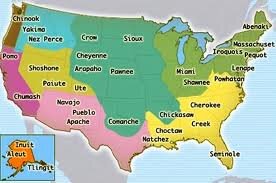Who are the Apache?
The Apache tribe was a nomadic group that lived in a large area in Southwestern America as well as parts of Mexico. Learn about their politics, society, and culture, as well how they dealt with the Spanish, Comanches, Mexicans, and the United States.
Who are the Apache?
The Apache tribe lived in a large region called the Gran Apacheria, which covered territory from Western Arizona to Eastern Texas, and from Northern Colorado to Mexico in the South. Since the region was so large, the Apaches naturally divided into two main groups, the Eastern and Western tribes, and the Rio Grande River served as a natural dividing line. Today, the Apache are mainly located in reservations in Arizona, New Mexico, and Oklahoma.
Map showing location of the Apache tribe
The name 'Apache' is a word the Spanish used to describe them, and it means 'enemy.' The Apache had many other names for themselves, including 'Inde,' which means 'the people.' They also were made up of many independent tribes, and each tribe had their own name for their specific tribe. Some tribes were the Lipan, Limita, Conejero, and Trementina.
Apache Politics
Historians believe that the Apaches came to Southwest America sometime between 1000 and 1400 C.E. The Apache tribe was broken up into many smaller tribes. The basic unit for the Apache was extended family. These family groups acted completely independent of one another. Extended families stayed together in a group and were led by the most important member of their family. That leader was the chief advisor and took care of the entire group's affairs. Many groups of extended families lived near each other so that they could unite for social, religious, and military purposes. They would decide on a band leader for the combined group whenever they met up.
The Apache was never a unified political union. The very loose-knit organization of the Apache tribe caused many problems for them throughout history. It was very difficult for them to have good relations with the Spanish, Mexicans, Americans, or other Indian tribes. This was because one Apache band might make peace with a nation or tribe, but another Apache band would remain at war with that same nation or tribe. This caused confusion among the Spanish, Mexicans, Americans, and other Indian tribes, and they would often retaliate against the wrong Apache band.
Apache Society and Culture
The Apache tribe was a nomadic group, and their lives revolved around the buffalo. They wore buffalo skins, slept in buffalo-hide tents, and ate buffalo for their sustenance. They were one of the first Indian tribes to learn to ride horses, and they quickly began using horses in order to hunt the buffalo. They also foraged for some berries and plants for additional food. They did not, however, eat fish or bear, because these were both considered unclean for eating.
In Apache society, both men and women were important to the tribe. Only men were chosen as band leaders, but women held important roles in the tribe as well. Apache society was matrilineal. After a marriage took place, the groom moved in with the bride's family, and from that moment on, he hunted and worked with his in-laws' family members. Even if his wife died, the husband stayed with her family, and her family would help him find a new bride. Men were allowed to marry more than one woman, but only wealthy leaders did this. If he did remarry, it was usually a sister or cousin of his wife.
Until the Spanish arrived in their territory, the Apache and Pueblo Indians had a peaceful and economic relationship with each other. The Pueblo tribe traded the agricultural products from their farms and also their pottery in exchange for buffalo meat and hides. This meant that the Apache did not have to focus on growing their own produce or making cultural products and instead could focus all of their energy on buffalo hunting. After the arrival of the Spanish, the peaceful trade network between the Pueblo and Apache was disrupted. The Spanish wanted to trade with the Apache and did everything in their power to diminish the Pueblo trading abilities; they were successful in this endeavor.
The Apache had many ceremonies that they celebrated throughout the year. These ceremonies often focused on certain dances. For example, they celebrated a girl's entrance into womanhood with the Sunrise Dance. The Apache believed that when a girl performed the Sunrise Dance, she was given special blessings to help her in life. Another dance was the Crown Dance, also known as the Mountain Spirit Dance. This dance was a masked dance, and the dancers would impersonate mountain spirits.



